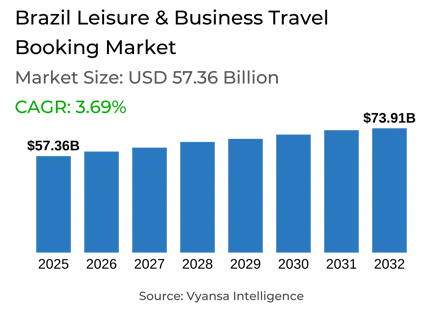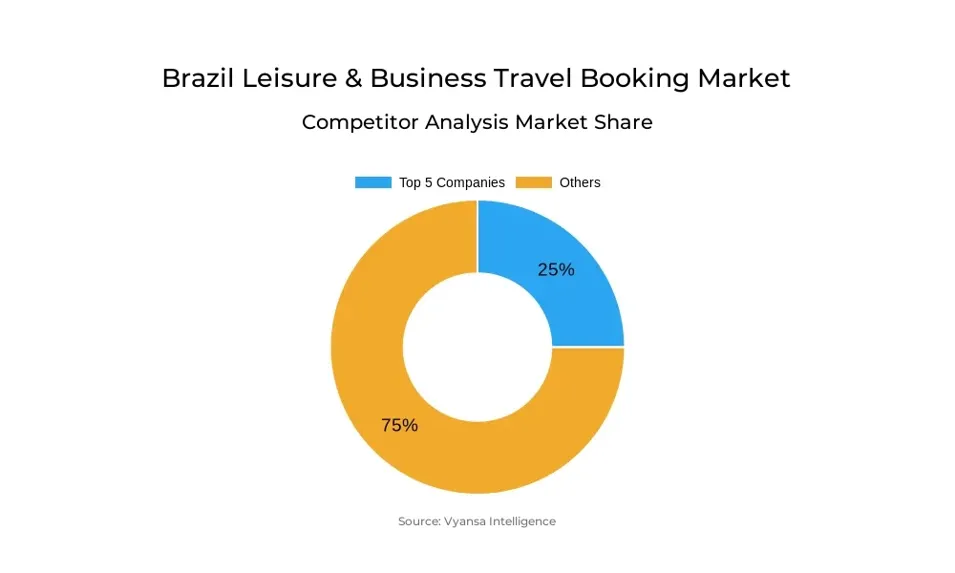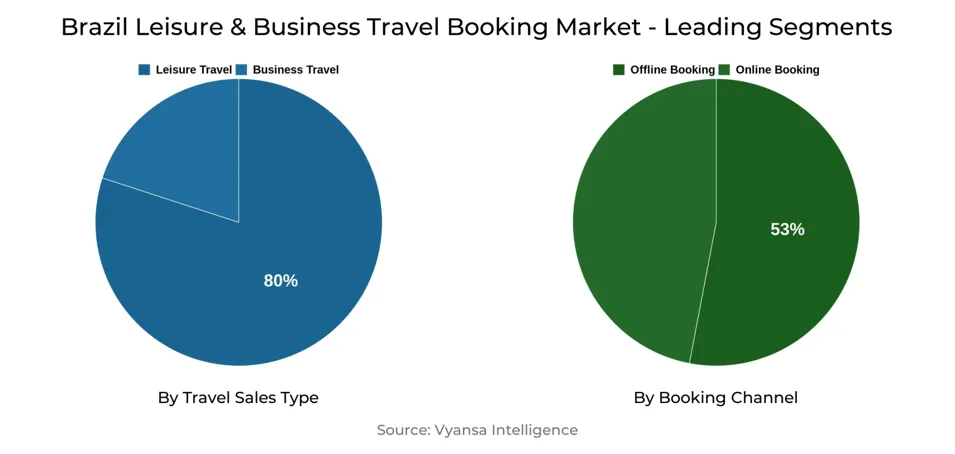
Brazil Leisure & Business Travel Booking Market Report: Trends, Growth and Forecast (2026-2032)
By Travel Sales Type (Leisure Travel, Business Travel), By Booking Channel (Offline Booking, Online Booking), By Booking Method (Travel Intermediaries, Direct Suppliers)
- ICT
- Nov 2025
- VI0384
- 130
-




Brazil Leisure & Business Travel Booking Market Statistics and Insights, 2026
- Market Size Statistics
- Leisure & Business Travel Booking in Brazil is estimated at $ 57.36 Billion.
- The market size is expected to grow to $ 73.91 Billion by 2032.
- Market to register a CAGR of around 3.69% during 2026-32.
- Travel Sales Type Shares
- Leisure Travel grabbed market share of 80%.
- Competition
- Brazil Leisure & Business Travel Booking Market is currently being catered to by more than 5 companies.
- Top 5 companies acquired 25% of the market share.
- Hotel Urbano Serviços Digitais SA, Flytour, Grupo, Alatur JTB Viagens e Turismo SA, Decolar.com Ltda, CVC Brasil Operadora e Agência de Viagens SA etc., are few of the top companies.
- Booking Channel
- Offline Booking grabbed 53% of the market.
Brazil Leisure & Business Travel Booking Market Outlook
Brazil Leisure & Business Travel Booking Market is exhibiting consistent recovery and growth, driven by leisure and corporate demand. Business travel bookings recovered smartly in 2023, almost reaching pre-pandemic levels and continuing to grow in 2024. This recovery indicates the dynamic economy of the country and stability brought about by business travel through long-term arrangements with airlines, hotels, and service providers. Business travel supports consistent occupancy even during low-demand periods and is an important driver of market resilience.
On the leisure front, classic agencies like CVC and Flytour have consolidated their market power, particularly post-crisis of 123 Milhas. end user skepticism of digital-only platforms has redirected demand toward agencies that offer personal service, support across channels, and face-to-face contact. Conceptual initiatives such as CVC Me Leva, which are centered on tourism associated with concerts, sports events, and cultural celebrations, are assisting in drawing in younger travelers who generally eschew intermediaries.
Recreation cruises are also generating new opportunities. Originally a stronghold of older travelers, cruises are increasingly popular with Millennials and Generation Z, fuelled by themed activities, music festivals on board, and the popularity of budget all-inclusive models. Social media presence and investments in onboard amenities like flexible dining, water parks, and extended port stays are further increasing the segment's appeal, facilitated by players like BestBuy, which opened a dedicated cruise department in 2024.
Brazil Leisure & Business Travel Booking Market is worth USD 57.36 billion and could rise to USD 73.91 billion by 2032. Offline booking remains predominant with 53% market share as there is steady demand for personalised and reliable services even in a highly digitalised setting. This integration of ancient trust and latest digital ease will define the industry outlook during the forecast period.

Brazil Leisure & Business Travel Booking Market Growth Driver
Recovery of Business Travel
Business travel is recovering strongly, with bookings returning to almost pre-pandemic levels and continuing their upward trend. Backing this recovery is a vibrant economy that is generating more corporate journeys and business movements throughout the nation. The consistent corporate demand for flights, accommodation, and car hire gives the travel sector a solid foundation even when leisure tourism falters.
This rebound functions as a major catalyst, with corporate customers typically engaging in medium- and long-term agreements, so service providers have steady revenue. The consistency of business travel makes it easier for airlines, hotels, and intermediaries to maintain profitability and occupancy during low-demand periods. With continued demand growth, business travel lends credence to the industry overall resilience and enables sustainable expansion across both leisure and corporate travel segments.
Brazil Leisure & Business Travel Booking Market Trend
Personalised Experience Boom
Travelers are more and more looking for individualized and customized travel experiences, away from mass packages. Tour operators like CVC and Flytour are adjusting accordingly by providing personalized services that underscore their worth over purely digital platforms. Their storefront presence and immediacy of problem-solving instill confidence in travelers who value reliability. By balancing old strengths with the latest omnichannel services, such tour operators are effectively acquiring and retaining customers.
A good case in point is CVC's Me Leva program, which targets tourism associated with concerts, sporting events, and cultural festivals. These tours entail tickets, lodging, and transportation, with special experiences that offer visitors a feeling of differentiation. Through social media and electronic marketing, CVC reaches younger travelers who typically prefer to make their own travel arrangements. This is because there is an increasing need for customized and experiential travel beyond fixed itineraries.
Brazil Leisure & Business Travel Booking Market Opportunity
Increasing Need for Recreational Cruises
Leisure cruises are becoming a highly promising opportunity, with the demand growing immensely through themed experiences that are highly appealing to younger generations. Although cruises were once popular with Baby Boomers and Generation X, Millennials and Generation Z are increasingly drawn to products offering experiences that merge entertainment, cultural attractions, and destination travel. The all-inclusive model further enhances this attraction since it ensures cost transparency and an easy means of visiting multiple destinations in one trip.
Increased social media influence further increases this trend, with younger travellers closely following cruise experiences with top national artists. In order to tap this, cruise operators are further outfitting their ships with flexible dining, increased onboard entertainment options, and extended port stays. Investments in specialist departments and training employees demonstrate the way the industry is working to engage and retain this new, younger customer segment.
Brazil Leisure & Business Travel Booking Market Segmentation Analysis

By Booking Channel
- Offline Booking
- Online Booking
The segmentation with the highest market share under Booking Channel is offline booking at 53%. This predominance is indicative of end-user faith in conventional agencies that yield customized services, physical presence, and robust customer support. Having experienced recent upsets within the industry, most travellers still see value in offline channels' reliability, particularly for more intricate or higher-value journeys. These organizations consolidate their position with customized packages, problem-solving skills, and established customer relations.
Yet, the pace is rapidly building in online booking, underpinned by the growth of digital websites like Booking.com, Airbnb, and Expedia. Smartphone and internet penetration is likely to drive this trend higher, making booking easier and more convenient. End users are more and more using apps to check prices, review ratings, and book services. Car hire, for example, is experiencing increased online pre-booking, with digital check-in and check-out facilities speeding up the process and making it more efficient.
Top Companies in Brazil Leisure & Business Travel Booking Market
The top companies operating in the market include Hotel Urbano Serviços Digitais SA, Flytour, Grupo, Alatur JTB Viagens e Turismo SA, Decolar.com Ltda, CVC Brasil Operadora e Agência de Viagens SA, Befly Travel Participações SA, Booking.com Brasil Servicos de Reserva LTDA, CWT Brasil, etc., are the top players operating in the Brazil Leisure & Business Travel Booking Market.
Frequently Asked Questions
Related Report
1. Market Segmentation
1.1. Research Scope
1.2. Research Methodology
1.3. Definitions and Assumptions
2. Executive Summary
3. Brazil Leisure & Business Travel Booking Market Policies, Regulations, and Standards
4. Brazil Leisure & Business Travel Booking Market Dynamics
4.1. Growth Factors
4.2. Challenges
4.3. Trends
4.4. Opportunities
5. Brazil Leisure & Business Travel Booking Market Statistics, 2022-2032F
5.1. Market Size & Growth Outlook
5.1.1. By Revenues in US$ Million
5.2. Market Segmentation & Growth Outlook
5.2.1. By Travel Sales Type
5.2.1.1. Leisure Travel- Market Insights and Forecast 2022-2032, USD Million
5.2.1.2. Business Travel- Market Insights and Forecast 2022-2032, USD Million
5.2.2. By Booking Channel
5.2.2.1. Offline Booking- Market Insights and Forecast 2022-2032, USD Million
5.2.2.2. Online Booking- Market Insights and Forecast 2022-2032, USD Million
5.2.3. By Booking Method
5.2.3.1. Travel Intermediaries- Market Insights and Forecast 2022-2032, USD Million
5.2.3.2. Direct Suppliers- Market Insights and Forecast 2022-2032, USD Million
5.2.4. By Competitors
5.2.4.1. Competition Characteristics
5.2.4.2. Market Share & Analysis
6. Brazil Leisure Travel Booking Market Statistics, 2022-2032F
6.1. Market Size & Growth Outlook
6.1.1. By Revenues in US$ Million
6.2. Market Segmentation & Growth Outlook
6.2.1. By Travel Sales Type- Market Insights and Forecast 2022-2032, USD Million
6.2.1.1. Leisure Air Travel- Market Insights and Forecast 2022-2032, USD Million
6.2.1.2. Leisure Car Rental- Market Insights and Forecast 2022-2032, USD Million
6.2.1.3. Leisure Cruise- Market Insights and Forecast 2022-2032, USD Million
6.2.1.4. Leisure Experiences and Attractions- Market Insights and Forecast 2022-2032, USD Million
6.2.1.5. Leisure Lodging- Market Insights and Forecast 2022-2032, USD Million
6.2.2. By Booking Channel- Market Insights and Forecast 2022-2032, USD Million
6.2.3. By Booking Method- Market Insights and Forecast 2022-2032, USD Million
7. Brazil Business Travel Booking Market Statistics, 2022-2032F
7.1. Market Size & Growth Outlook
7.1.1. By Revenues in US$ Million
7.2. Market Segmentation & Growth Outlook
7.2.1. By Travel Sales Type- Market Insights and Forecast 2022-2032, USD Million
7.2.1.1. Business Air Travel- Market Insights and Forecast 2022-2032, USD Million
7.2.1.2. Business Car Rental- Market Insights and Forecast 2022-2032, USD Million
7.2.1.3. Business Lodging- Market Insights and Forecast 2022-2032, USD Million
7.2.1.4. Others- Market Insights and Forecast 2022-2032, USD Million
7.2.2. By Booking Channel- Market Insights and Forecast 2022-2032, USD Million
7.2.3. By Booking Method- Market Insights and Forecast 2022-2032, USD Million
8. Competitive Outlook
8.1. Company Profiles
8.1.1. Decolar.com Ltda
8.1.1.1. Business Description
8.1.1.2. Service Portfolio
8.1.1.3. Collaborations & Alliances
8.1.1.4. Recent Developments
8.1.1.5. Financial Details
8.1.1.6. Others
8.1.2. CVC Brasil Operadora e Agência de Viagens SAs
8.1.2.1. Business Description
8.1.2.2. Service Portfolio
8.1.2.3. Collaborations & Alliances
8.1.2.4. Recent Developments
8.1.2.5. Financial Details
8.1.2.6. Others
8.1.3. Befly Travel Participações SA
8.1.3.1. Business Description
8.1.3.2. Service Portfolio
8.1.3.3. Collaborations & Alliances
8.1.3.4. Recent Developments
8.1.3.5. Financial Details
8.1.3.6. Others
8.1.4. Booking.com Brasil Serviços de Reserva LTDA
8.1.4.1. Business Description
8.1.4.2. Service Portfolio
8.1.4.3. Collaborations & Alliances
8.1.4.4. Recent Developments
8.1.4.5. Financial Details
8.1.4.6. Others
8.1.5. CWT Brasil
8.1.5.1. Business Description
8.1.5.2. Service Portfolio
8.1.5.3. Collaborations & Alliances
8.1.5.4. Recent Developments
8.1.5.5. Financial Details
8.1.5.6. Others
8.1.6. Hotel Urbano Serviços Digitais SA
8.1.6.1. Business Description
8.1.6.2. Service Portfolio
8.1.6.3. Collaborations & Alliances
8.1.6.4. Recent Developments
8.1.6.5. Financial Details
8.1.6.6. Others
8.1.7. Flytour, Grupo
8.1.7.1. Business Description
8.1.7.2. Service Portfolio
8.1.7.3. Collaborations & Alliances
8.1.7.4. Recent Developments
8.1.7.5. Financial Details
8.1.7.6. Others
8.1.8. Alatur JTB Viagens e Turismo SA
8.1.8.1. Business Description
8.1.8.2. Service Portfolio
8.1.8.3. Collaborations & Alliances
8.1.8.4. Recent Developments
8.1.8.5. Financial Details
8.1.8.6. Others
9. Disclaimer
| Segment | Sub-Segment |
|---|---|
| By Travel Sales Type |
|
| By Booking Channel |
|
| By Booking Method |
|
Research Methodology
This study followed a structured approach comprising four key phases to assess the size and scope of the electro-oxidation market. The process began with thorough secondary research to collect data on the target market, related markets, and broader industry context. These findings, along with preliminary assumptions and estimates, were then validated through extensive primary research involving industry experts from across the value chain. To calculate the overall market size, both top-down and bottom-up methodologies were employed. Finally, market segmentation and data triangulation techniques were applied to refine and validate segment-level estimations.
Secondary Research
The secondary research phase involved gathering data from a wide range of credible and published sources. This step helped in identifying industry trends, defining market segmentation, and understanding the market landscape and value chain.
Sources consulted during this phase included:
- Company annual reports, investor presentations, and press releases
- Industry white papers and certified publications
- Trade directories and market-recognized databases
- Articles from authoritative authors and reputable journals
- Gold and silver standard websites
Secondary research was critical in mapping out the industry's value chain and monetary flow, identifying key market segments, understanding regional variations, and tracking significant industry developments.
Other key sources:
- Financial disclosures
- Industry associations and trade bodies
- News outlets and business magazines
- Academic journals and research studies
- Paid industry databases
Primary Research
To validate secondary data and gain deeper market insights, primary research was conducted with key stakeholders across both the supply and demand sides of the market.
On the demand side, participants included decision-makers and influencers from end-user industries—such as CIOs, CTOs, and CSOs—who provided first-hand perspectives on market needs, product usage, and future expectations.
On the supply side, interviews were conducted with manufacturers, industry associations, and institutional participants to gather insights into current offerings, product pipelines, and market challenges.
Primary interviews provided critical inputs such as:
- Market size and revenue data
- Product and service breakdowns
- Market forecasts
- Regional and application-specific trends
Stakeholders consulted included:
- Leading OEM and solution providers
- Channel and distribution partners
- End users across various applications
- Independent consultants and industry specialists
Market Size Estimation and Data Triangulation
- Identifying Key Market Participants (Secondary Research)
- Goal: To identify the major players or companies in the target market. This typically involves using publicly available data sources such as industry reports, market research publications, and financial statements of companies.
- Tools: Reports from firms like Gartner, Forrester, Euromonitor, Statista, IBISWorld, and others. Public financial statements, news articles, and press releases from top market players.
- Extracting Earnings of Key Market Participants
- Goal: To estimate the earnings generated from the product or service being analyzed. This step helps in understanding the revenue potential of each market player in a specific geography.
- Methods: Earnings data can be gathered from:
- Publicly available financial reports (for listed companies).
- Interviews and primary data sources from professionals, such as Directors, VPs, SVPs, etc. This is especially useful for understanding more nuanced, internal data that isn't publicly disclosed.
- Annual reports and investor presentations of key players.
- Data Collation and Development of a Relevant Data Model
- Goal: To collate inputs from both primary and secondary sources into a structured, data-driven model for market estimation. This model will incorporate key market KPIs and any independent variables relevant to the market.
- Key KPIs: These could include:
- Market size, growth rate, and demand drivers.
- Industry-specific metrics like market share, average revenue per customer (ARPC), or average deal size.
- External variables, such as economic growth rates, inflation rates, or commodity prices, that could affect the market.
- Data Modeling: Based on this data, the market forecasts are developed for the next 5 years. A combination of trend analysis, scenario modeling, and statistical regression might be used to generate projections.
- Scenario Analysis
- Goal: To test different assumptions and validate how sensitive the market is to changes in key variables (e.g., market demand, regulatory changes, technological disruptions).
- Types of Scenarios:
- Base Case: Based on current assumptions and historical data.
- Best-Case Scenario: Assuming favorable market conditions, regulatory environments, and technological advancements.
- Worst-Case Scenario: Accounting for adverse factors, such as economic downturns, stricter regulations, or unexpected disruptions.
Partnering With Industry Leaders to Drive Growth
Our mission is to deliver intelligence that matters. By combining data, analysis, and industry expertise, we enable organizations to make smarter, faster, and more impactful decisions. Whether it’s a Fortune 500 company or a high-growth startup, businesses trust us to provide clarity in an ever-evolving marketplace.






